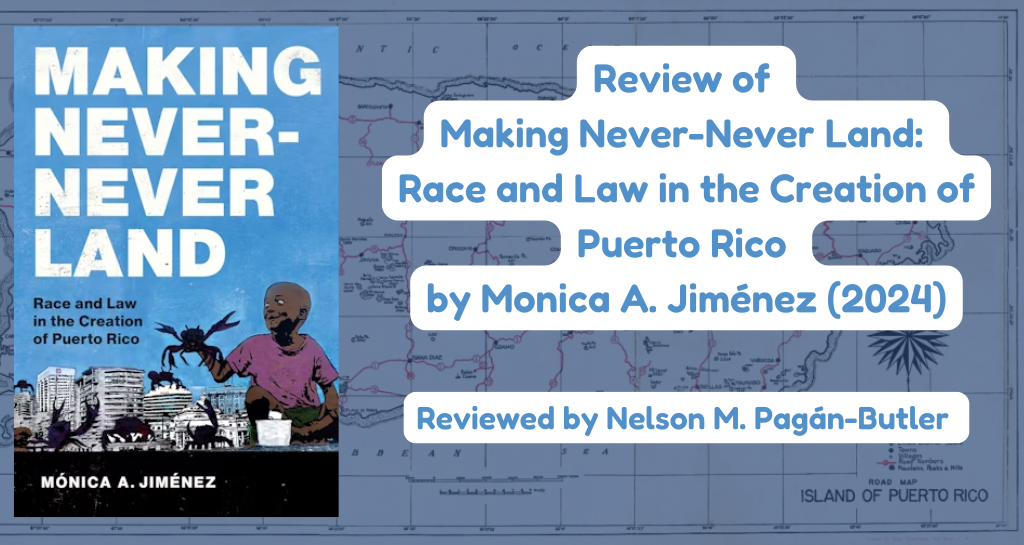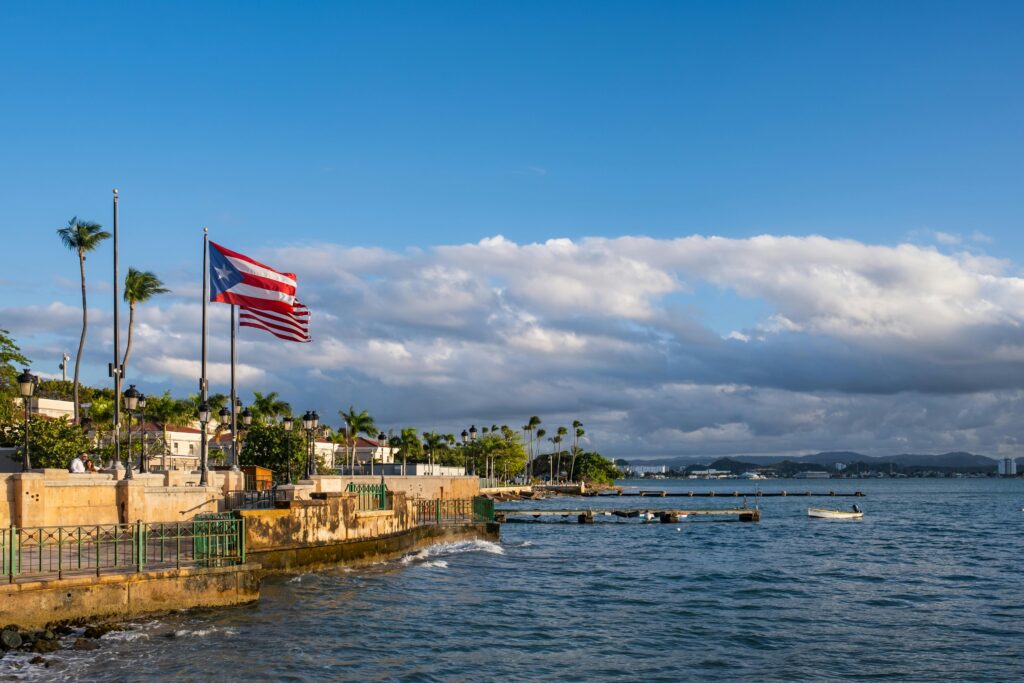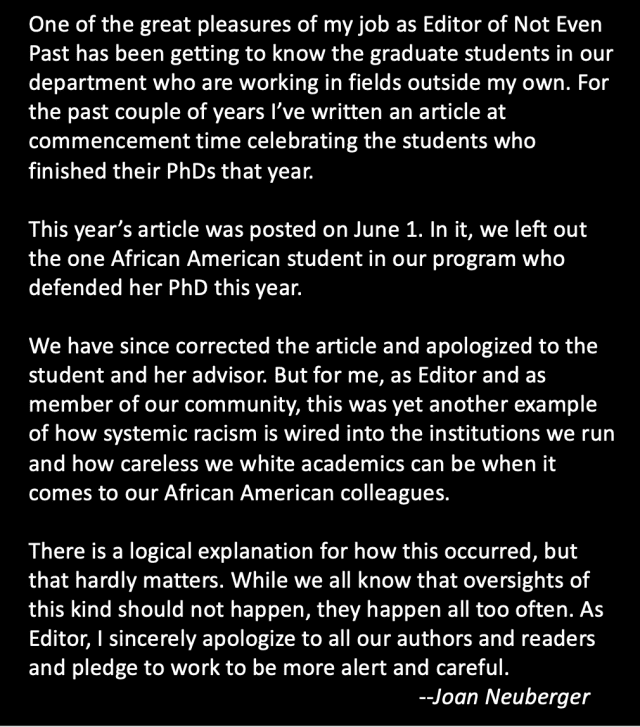
In Making Never-Never Land: Race and Law in the Creation of Puerto Rico, Caribbean historian, and Black studies scholar Mónica A. Jiménez offers a new interpretation of Puerto Rican legal and political history. In her first book-length project, Jiménez explores the intersections between law, and race in the creation of Puerto Rico. More specifically, Making Never-Never Land interrogates how these intersections have framed the relationship between the United States and Puerto Rico since the territory was ceded by Spain in 1898. The book is shaped by Jiménez’s personal experience as a diasporic scholar moving from Puerto Rico to Texas. Jiménez’s family joined the first wave of Puerto Ricans who left for Houston, Texas in the mid-1980s in search of better economic opportunities which is part of a broader colonial history of forced migration, economic hardship, and discrimination. Jiménez seeks to answer the question: What is Puerto Rico for the United States? This is a question that many Puerto Ricans living in and out of the United States ask themselves every day. This question shapes Puerto Rican colonial history as a territory, historically and currently, especially following the imposition of the Puerto Rico Oversight, Management, and Economic Stability Act (also known as PROMESA).
Throughout Making Never-Never Land, Jiménez examines the larger history of U.S. settler colonialism and racial exclusion, using an analysis of the United States Supreme Court’s decisions to better understand the unincorporated territory’s current debt crisis and disaster capitalism situation. She argues that PROMESA, which was meant to take care of Puerto Rico’s outstanding debt, reaffirmed the United States Congress’ plenary powers over the island and “effectively stripped the territory of its ability to self-govern” (p.119).

To understand the limitations of a group of US Supreme Court decisions known collectively as the Insular Cases and interrogate the “state of exception” created by them, Jiménez draws back to place the Insular Cases within a more extended legal history of racial exclusion towards Native Americans, and African Americans. By closely examining early legal precedents and analyzing these cases together, in Making Never-Never Land Jiménez invites us to consider how race functions within them, shaping Puerto Rico’s present and future. Through this critical reading, she positions herself as an anti-colonial scholar with a deep understanding of Puerto Rican politics. She does not believe that simply overturning the Insular Cases will resolve the island’s challenges. Instead, she urges the reader to think about Puerto Rico’s colonial status and its history of exploitation and subjugation more broadly, which are deeply tied to the racism embedded in those decisions, as a deliberate legal reality. Rejecting that legal logic as valid is, a crucial first step, for her.

Making Never-Never Land is divided into two parts. The first part, “Toward a Legal Genealogy of Racial Exclusion” looks at the US Supreme Court’s resolution of the Insular Cases, particularly Downes v. Bidwell (1901), a foundational case that first established the legal framework of U.S.-Puerto Rico relations, placing that decision within a longer historical context of legal decisions before the United States’ acquisition of the territory. Chapter 1 puts the focus on Downes because it was in that case that the US Supreme Court pronounced Puerto Rico to be “foreign in a domestic sense,” and created a new legal category, “the unincorporated territory,” for the island effectively placing it in a legal limbo—neither fully part of the U.S. nor fully independent (pp. 19, 20). That decision created a series of limitations for the territory, continuing to undermine its sovereignty.
Chapter 2 examines the Marshall Trilogy (1823-1832), United States v. Rogers (1846), and Dread Scott v. Sanford (1856) concerning the rights of Native Americans and enslaved Africans, respectively, who were among the first nonwhite populations with whom the U.S. legal system had to contend, to connect their logics and legal reasoning to Downes. In these cases, according to Jiménez, the U.S. Supreme Court engaged in critical moments of racial formation and exclusion, were we see the birth and growth of plenary powers, creating what the authors refers to as the “American state of exception”.
In the second part of the book, “‘American’ State of Exception: Puerto Rico in the Twentieth and Twenty-First Centuries”, Jiménez traces the legal, political, and social effects and logics of Downes into the present with implications for the future. She does this by identifying three key moments that established the limits of Puerto Rico’s relationship to the United States. For example, chapter 3 examines the immediate changes implemented after the United States acquired Puerto Rico as an overseas territory, and the Court’s ruling in Downes. Jiménez describes this process as “the creation of Puerto Rico as an experimental station,” where the island became a testing ground for colonial policies, and its inhabitants were subjected to a process of “Americanization” and were taught how to become proper U.S. colonial subjects (p. 63).

Source: Wikimedia Commons.
Chapter 4 examines the events that led to “the midcentury miracle,” which lifted many Puerto Ricans out of poverty and culminated in the establishment of the Estado Libre Asociado (E.L.A.), or Commonwealth of Puerto Rico, in 1952. While acknowledging the benefits this period brought to some, including her own grandfather’s success story, Jiménez highlights the limits of Puerto Rico’s political authority and the overarching control of Congress’ plenary powers over the archipelago, much like Puerto Rican Nationalist Party leader Pedro Albizu Campos once did. In her effort to demystify archives of Puertorriqueñidad, the sense of Puerto Rican identity that became involved with the notion of E.L.A., she examines how Congress’ supremacy was reaffirmed in a series of U.S. Supreme Court decisions from 2016 to 2020 concerning Puerto Rico’s current debt crisis. In Chapter 5, Jiménez further develops how the Court once again upheld the precedent set in Downes, reinforcing the island’s colonial condition.
Jiménez’s Making Never-Never Land makes a significant contribution to Puerto Rican Studies, American Studies, Legal Studies, and Caribbean Studies, by interrogating the U.S. Supreme Court’s decisions through the lens of racial and colonial exclusion. Her work expands our understanding of unincorporated territories—Puerto Rico, Guam, the U.S. Virgin Islands, the Northern Mariana Islands, and American Samoa—and their relationship to the U.S. As a legal historian, Jiménez challenges the fiction that Puerto Rico holds real decision-making power, highlighting how Downes continues to justify the island’s exclusion and inequality. Her greatest scholarly intervention is tracing the genealogy of court decisions that have systematically stripped Puerto Rico of sovereignty, culminating in the imposition of PROMESA in 2016. By revisiting cases like Downes, she opens new avenues for understanding the present by rethinking Puerto Rico’s political and legal status.

Source: Wikimedia Commons
Jiménez’s Making Never-Never Land arrives at a crucial moment when Puerto Rican Studies scholars are examining critically how the United States treats its overseas territories. She not only expands these conversations but also moves beyond centering the debate on the Insular Cases, critically interrogating their lasting impact on Puerto Rico today. In doing so, she builds on the work of legal scholars like Efrén Rivera Ramos, David E. Wilkins, Maggie Blackhawk, Paul Finkelman, and Adam Arenson, among many others. Her research also engages with Ed Morales’ Fantasy Island: Colonialism, Exploitation, and the Betrayal of Puerto Rico (2019) and Rocío Zambrana’s Colonial Debts: The Case of Puerto Rico (2021), particularly in the context of Puerto Rico’s debt crisis and disaster capitalism, making it a timely and innovative contribution. Jiménez is also successful in expanding the conversation to other states of the U.S., as this book also helps us understand the colonial dynamics still present with Native Hawaiians.
Making Never-Never Land is well-suited for courses in Puerto Rican, and Caribbean Studies, American, African Diaspora, and Legal Studies, as it addresses race, discrimination, law, citizenship, U.S.-Puerto Rico relations, and colonialism while encouraging critical engagement with these legal precedents. Additionally, Jiménez’s intersectional approach to race and law makes her work relevant for students in Native American and Black Studies. Ultimately, this book challenges us to rethink legal narratives and their ongoing consequences, urging a more profound reconsideration of Puerto Rico’s political and legal status.
Nelson M. Pagán-Butler is a Ph.D. student in the Department of Spanish and Portuguese at the University of Texas at Austin. His research explores Afro-descendant intellectuals in the Hispanic Caribbean, Black Caribbean feminist and Marxist thought, and Hispanic Caribbean queer archives.
The views and opinions expressed in this article or video are those of the individual author(s) or presenter(s) and do not necessarily reflect the policy or views of the editors at Not Even Past, the UT Department of History, the University of Texas at Austin, or the UT System Board of Regents. Not Even Past is an online public history magazine rather than a peer-reviewed academic journal. While we make efforts to ensure that factual information in articles was obtained from reliable sources, Not Even Past is not responsible for any errors or omissions.




